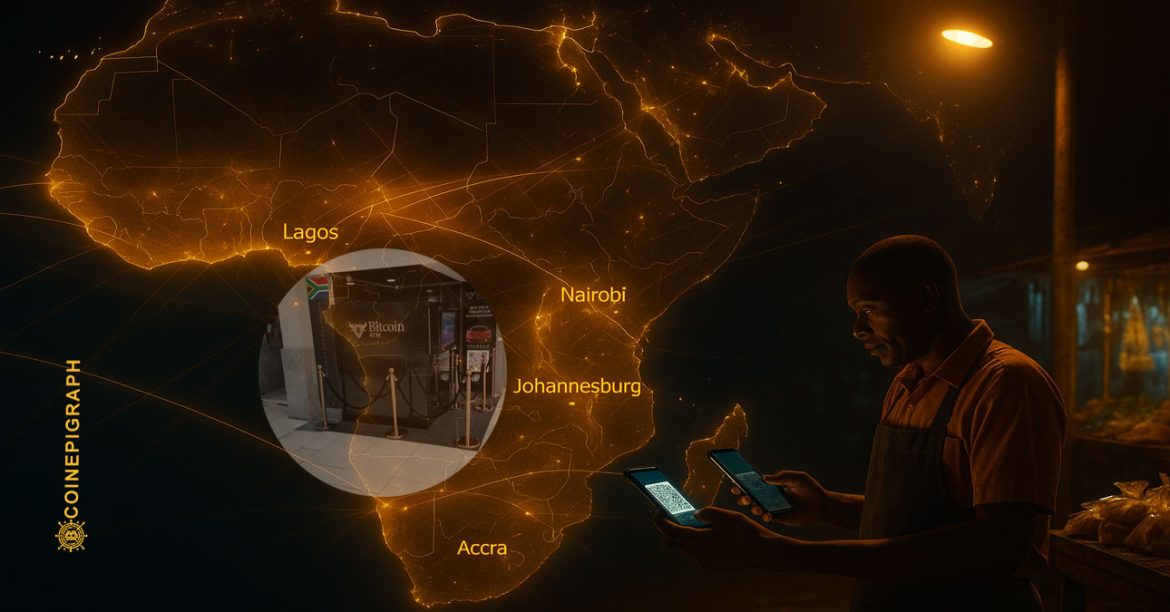By CoinEpigraph Editorial Desk | Africa
From Johannesburg terminals to Nairobi malls, crypto is stepping out of the blockchain and into the real world — transforming how the continent pays, saves, and asserts Africa financial sovereignty.
The Opening Scene — Crypto in Motion
Start cinematic: a traveler scanning a QR code at Johannesburg’s O.R. Tambo Airport to buy coffee with USDT or BTC; a matatu driver in Nairobi flashing a digital wallet QR on his window.
The key message: Africa’s crypto story has evolved from speculation to transaction.
No longer confined to exchanges and phone screens — it’s now part of the everyday movement of value.
“Crypto is no longer an app — it’s an interface.”
The Physicalization of the Blockchain
Across Africa, physical merchant adoption is exploding:
- South Africa: retail crypto terminals at Capetown and Johannesburg airports.
- Kenya: Safaricom’s M-PESA integrations and stablecoin pilots.
- Nigeria: POS and crypto kiosks emerging despite regulatory tension.
- Ghana & Zambia: pilot zones testing hybrid CBDC–stablecoin rails.
This is the onramp revolution — where crypto becomes visible in stores, kiosks, and devices.
Sovereignty by Adoption, Not Declaration
Governments debate policy; citizens just adopt.
Where banking systems are fragmented or exclusionary, crypto fills the gap — not by ideology, but necessity.
Every physical transaction that clears in digital currency chips away at the old dependency structures — a subtle form of monetary decolonization.
Infrastructure Over Ideology
Behind the scenes, Africa is becoming a laboratory for new payment rails:
- Stellar Foundation partnerships in East Africa.
- Cardano and World Mobile expansion into telecom payments.
- Binance Pay and Yellow Card enabling borderless retail liquidity.
The continent’s fragmented fiat landscape turns out to be a feature, not a flaw — it accelerates multi-asset interoperability faster than most developed markets.
The Policy Catch-Up
Regulators across the AU are realizing that banning crypto merely pushes it underground.
Kenya, South Africa, and Botswana are drafting frameworks to classify digital payments without killing innovation.
The African Continental Free Trade Area (AfCFTA) is already studying cross-border digital currency corridors.
“Africa might not issue the next world reserve — but it may define how it moves.”
The Real Frontier
The “physical frontier” is symbolic:
- ATMs dispensing stablecoins.
- Street vendors accepting Lightning payments.
- Airports hosting digital currency exchanges.
The blockchain isn’t staying virtual.
It’s going tactile, sensory, visible — embedded in everyday African life.
And once people see crypto, they begin to trust it differently.
Closing Reflection
While traveling we experienced Africa’s digital currency movement which began as a whisper on smartphones; it’s now a visible current in physical space.
From terminals to taxis, markets to malls, the blockchain has found its body.
And in that embodiment, the continent is quietly redrawing the borders of global finance.
At Coinepigraph, we pride ourselves on delivering cryptocurrency news with the utmost journalistic integrity and professionalism. Our dedicated team is committed to providing accurate, insightful, and unbiased reporting to keep you informed in the ever-evolving crypto landscape. Stay tuned as we expand our coverage to include new sections and thought-provoking op-eds, ensuring Coinepigraph remains your trusted source for all things crypto. -Ian Mayzberg Editor-in-Chief
The team at CoinEpigraph.com is committed to independent analysis and a clear view of the evolving digital asset order.
To help sustain our work and editorial independence, we would appreciate your support of any amount of Bitcoin/Satoshi to this address below: 3NM7AAdxxaJ7jUhZ2nyfgcheWkrquvCzRm
and through our Support Page.
🔍 Disclaimer: CoinEpigraph is for entertainment and information, not investment advice. Markets are volatile — always conduct your own research.
COINEPIGRAPH does not offer investment advice. Always conduct thorough research before making any market decisions regarding cryptocurrency or other asset classes. Past performance is not a reliable indicator of future outcomes. All rights reserved 2024-2025.




